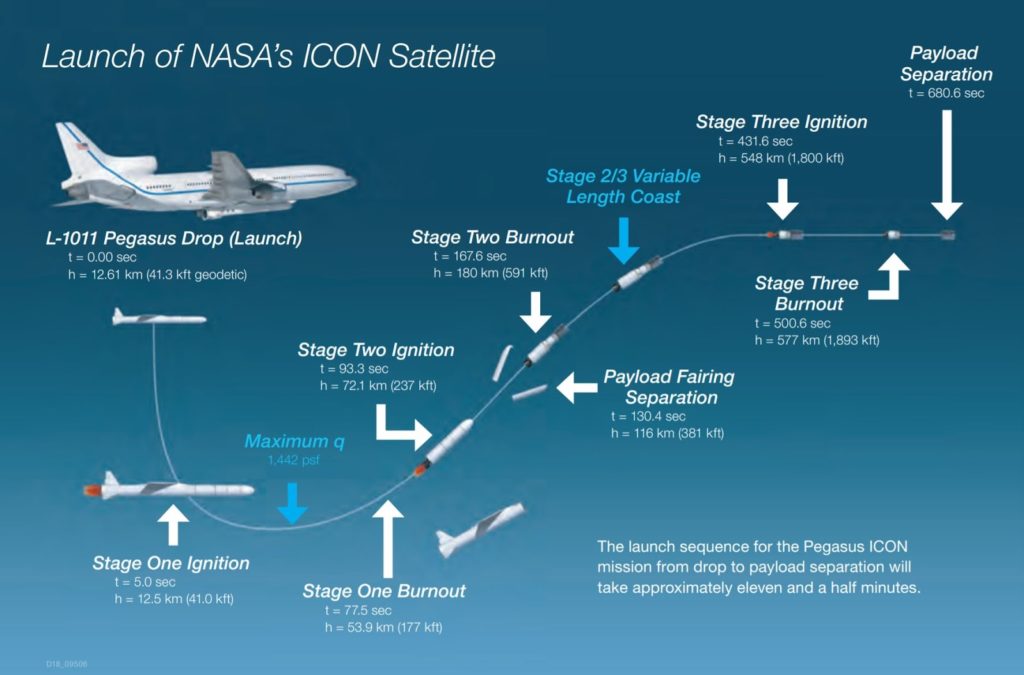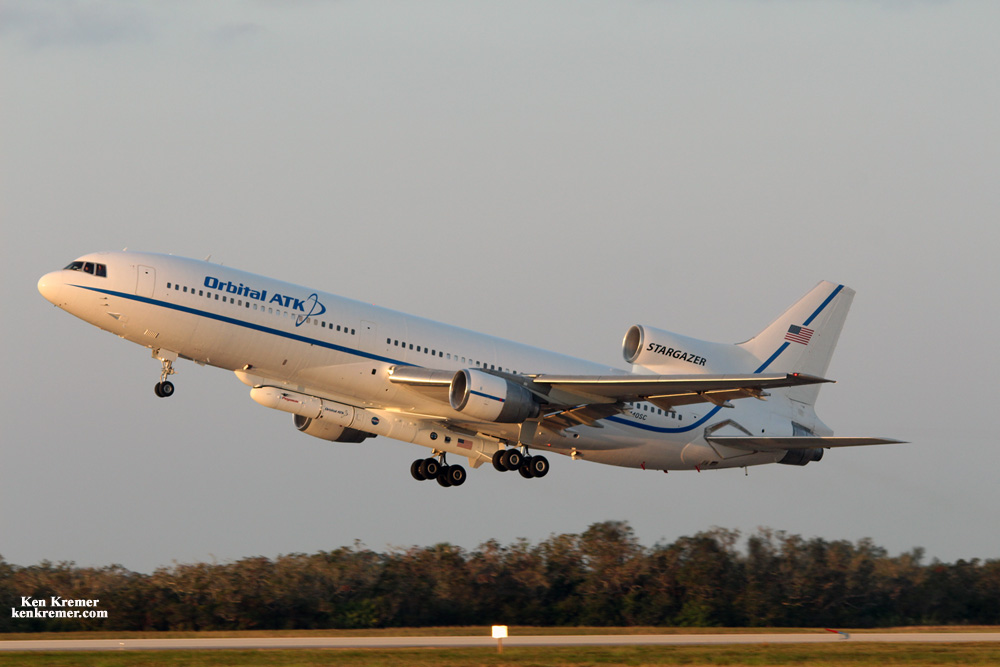KENNEDY SPACE CENTER & CAPE CANAVERAL AIR FORCE STATION,
FL – The oft delayed launch of NASA’s ICON ionospheric science exploration satellite has
been scrubbed yet again by NASA and Northrop Grumman due to a recurring troublesome
glitch with the pesky Pegasus XL rocket that surfaced less than 30 minutes before
the planned overnight launch in the wee hours of Wednesday, Nov. 7 at 3:05 a.m.
EST – potentially resulting in a weeks long postponement as investigators hunt for clues to the mysterious spurious signals.
No new launch target date has been set by the NASA and Northrop
Grumman team as they renew an investigation to identify the “root cause” and evaluate
fixes for the continuing
appearance of insidious off nominal data signatures seen while the Pegasus XL air-launched
rocket was airborne and attached to the belly of the company’s L-1011
Stargazer carrier jet – and aborted while approaching the drop zone some 200
miles (320 km) off shore of Daytona Beach, FL over the Atlantic Ocean.
Hopes by the team to try once again 24 hours later on Nov. 8
were dashed when time ran out to ensure a successful flight of Pegasus & ICON on
the last date in the current window of opportunity on the Eastern Range – Space
UpClose confirmed with the team.
Setting
a new launch date after Nov. 8 is complicated by the fact that the Eastern Range
is not available for roughly a week for regular maintenance work as well as the
fact that SpaceX has the range booked for a static test fire this Sunday,
Nov.11 ahead of a launch of their Falcon 9 rocket slated for no earlier than Nov.
15.
Enjoy our Space UpClose photo gallery of ICON, Pegasus XL rocket and L-1011 Stargazer direct at
the Skid Strip.
launched Pegasus XL rocket systems to confirm whether it was really ready to
carry ICON to orbit.
Stargazer
was soaring aloft and preparing to drop deploy Pegasus at an altitude of about 39,000
feet (12,000 meters) over the open Atlantic Ocean on an easterly heading of 105.0 degrees and 27 degree
inclination to the equator – until the launch abort was called.
ICON is NASA’s new science
mission to study the Earth’s ionosphere – the tenuous upper atmospheric layer
at the ‘frontier of space’ forming the dynamic boundary where Earth’s weather
meets space weather.
“NASA and Northrop Grumman are continuing to
investigate the off-nominal data observed during the Pegasus XL rocket’s Nov. 7
launch attempt for the agency’s Ionospheric Connection Explorer, or ICON,
mission,” NASA said in a statement.
“The
next launch attempt will be evaluated once the investigation is complete.”
Explorer (ICON) research satellite mission
is nestled inside the nose cone of the Pegasus XL rocket that’s cradled at the
belly of the Northrop Grumman L-1011 carrier jet named ‘Stargazer’ – the very last of its kind
still flying in the world.
The quoted
cost covers the ICON satellite, Pegasus launch and missions operations for the
baselined 2 years long Earth science mission.
The Pegasus XL rocket is an air-launched
rocket that launches horizontally midair after being dropped from the belly of
the L-1011 Stargazer at 39,000 ft. and with ignition of the first stage engine
burn, and then tilts up to space to begin the approximate eleven minute trek to
LEO.
The refrigerator-sized ICON weighs 634 pounds (288 kg) and
measures 76 inches long and 42 inches wide.
ICON is encapsulated inside the Pegasus nose cone. The
rocket is 57 feet (17 meters) long, 4.2 meters wing diameter
and weighs 52,920 pounds (24,000 kg).
The Northrop Grumman Pegasus XL rocket has been afflicted with
multiple anomalies forcing multiple launch delays over the past weeks and
months – as well as a complete change in the launch site from Kwajalein Atoll in the Marshall Islands to the Florida
Space Coast.
This week’s lengthy launch postponement is another in a
long string – BUT ensuring a safe and successful launch and mission is always
the absolute top priority!
The team will now stand down for an indefinite period.
NASA and Northrop Grumman officials held a Launch Readiness
Review (LRR) on Tuesday of this week to determine the Pegasus rockets fitness
for flight and whether the launch will
proceed as planned this week, officials told Space Up Close during a media tour
of the rocket and L-1011 carrier aircraft at the Skid Strip launch site on Cape
Canaveral Air Force Station, Friday, Nov. 2.
The ICON spacecraft itself has been healthy throughout,
reports NASA.
The Nov. 7 launch attempt of ICON was aborted
about an hour after takeoff “due to off-nominal data observed on the Pegasus XL
rocket, during the captive carry flight,” said NASA.
The ICON mission was originally planned to launch in 2017
but delayed due to mishandling of the rocket motors. Since than additional delays
were caused by anomalous data signatures with the Pegasus rocket that were detected
while the L-1011 was ferrying the probe in flight from Vandenberg Air Force
Base, Ca.
“We’ve had some Pegasus issues and are still working on
them,” Omar Baez, Sr. Launch Director, Launch Services Program, NASA Kennedy Space
Center, told Space UpClose in an interview at the Skid Strip.
“When we brought the plane over from Vandenberg it was
powered up and we saw some signatures on the Pegasus launch vehicle that did not
make us happy. So we have taken the time
to change out some components and try to exonerate the issues – and are doing
some analysis.”
Originally the root cause was traced to a
faulty sensor, which was replaced. But the off-nominal data reading recurred
forcing further data reviews and launch postponements.
“We are still working on the exact root cause and trying to
recreate the issues we saw in the operating environment at altitude,” Baez
explained.
The flight and rocket teams decided to conduct another test
flight of the combined L-1011/Pegasus XL/ICON last Sunday to collect and assess
data readings during a 4-hour, 45-minute flight that
tested the aircraft’s systems prior to launch.
safe to fly. We didn’t see the problem
again but we are still analyzing the data,” Baez elaborated.
is still a lot more work to be done. It takes time to analyze the data and
absord the whole picture and convince people its safe to fly.”
was very similar to what we saw earlier. It’s taken more time than expected. So
we are analyzing that.”
the issue further to make sure it doesn’t have us licked.”
|
Cockpit view of Northrop
Grumman’s L-1011 Stargazer aircraft slated to launch air-dropped Pegasus XL rocket and NASA ICON research satellite. Credit: Ken Kremer/kenkremer.com/spaceupclose.com |
L-1011 Stargazer was cruising to a target drop zone box about 200 miles (320 km) off the
east coast of Daytona Beach Nov. 7, when the launch was aborted at about 2:40 a.m.
ET.
drop point. That drop point is about 200 nautical miles east of Daytona,” said
Baez.
had gone well.
“ICON orbits at an operational altitude of 575 km – and the
instruments are all looking down in a horizontal orientation all the time. Except the ion meter which makes measurements
at the orbiting altitude,” said Robert Lockwood, Program Director, Science & Environmental
Satellites, Northrop Grumman, in an interview with Space UpClose at the Skid
Strip.
ICON will study the ionosphere
– “the mixed layer of charged and neutral particles extending from about 50 to
360 miles above Earth’s surface, through which radio communications and GPS
signals travel, and the processes there that can distort or even disrupt these
signals. Knowledge gleaned from this mission will aid in mitigating its effects
on satellites and communications technology worldwide.”
During a baselined 2-year-long mission, ICON
will explore the turbulent upper atmospheric ionosphere zone at the interface
between the Earth’s terrestrial weather below and space weather above where giant
winds whip up the particles – ionized by solar radiation.
The ionosphere is a “dynamic zone high in
Earth’s atmosphere can be a source of great beauty such as the aurora, but can
also be disruptive to radio communications and satellites and astronaut health.
ICON will help determine the physical processes at play in this “frontier of
space,” thus paving the way for mitigating their effects on our technology,
communications systems and society.”
ICON was built by Northrop Grumman and is based on the LEOStar-2
bus.
The science operations team is led by the University of
California, Berkeley. The probe is equipped with a suite four science
instruments that will track changes physical and chemical properties of the neutral
and charged atmospheric particles; MIGHTI, EUV, FUV and IVM.
“The ICON mission is looking at the interaction of the ionosphere
and the charged layer of particles at the top of the atmosphere with space
weather,” Lockwood explained.
“It has 4 instruments altogether including two UV
instruments [EUV & FUV], an in situ ion velocity meter [IVM] to measure the
speed of charged particles, and MIGHTI to measure the speed and temperature of
particles in the neutral atmosphere.”
“We know there are effects and correlation with whats
happening in the atmosphere and weather. But we don’t really know why.”
“So the science we are doing with ICON is are making
measurements to understand how the
weather systems effect the profile in the ionosphere.”
Overall this mission marks the 44th launch of Pegasus
XL since the maiden flight in 1990.
last Pegasus launch took place in December 2016 for the launch of NASA’s $157
million hurricane forecasting mission. Space UpClose was on hand – my photos
below.
Pegasus XL was the world’s first air-launched rocket
launching satellites to orbit. It utilizes the L-1011 carrier aircraft as an “air-breathing
reusable first stage” according to Northrop Grumman.
mission managed by NASA’s Goddard Space Flight Center, Greenbelt, MD.
Boeing, Lockheed Martin, Northrop Grumman and more space and mission reports direct
from the Kennedy Space Center, Cape Canaveral Air Force Station, Florida and
Wallops Flight Facility, Virginia.
and human spaceflight news: www.kenkremer.com –www.spaceupclose.com –
twitter @ken_kremer – email: ken at kenkremer.com
and journalist based in the KSC area.
Ken’s photos are for sale and he is available for lectures and outreach events



